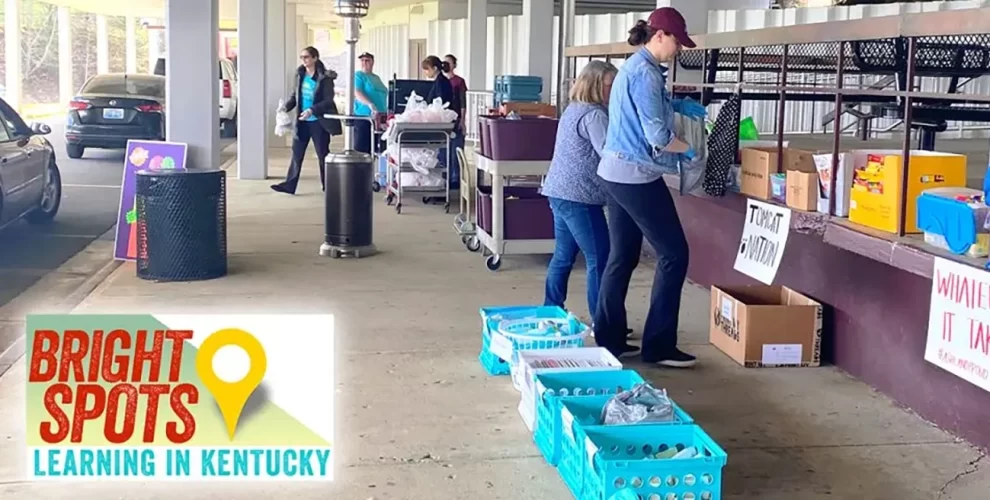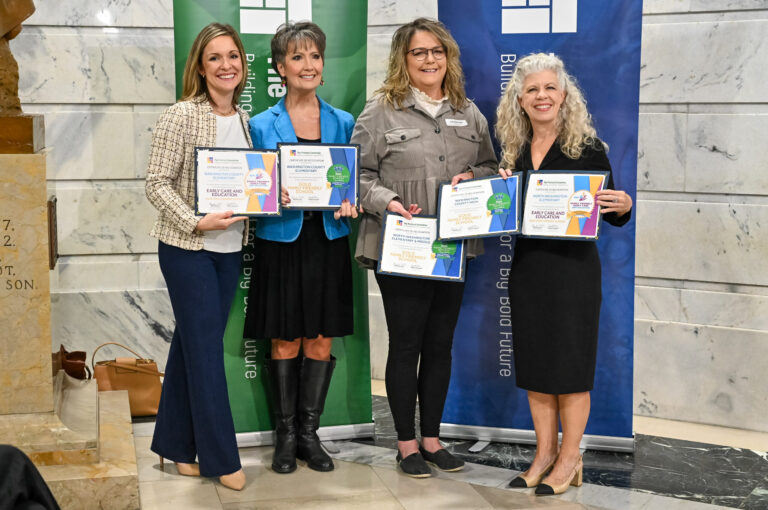CRISIS EXPANDS DEFINITION OF SCHOOL WORK

APRIL 2020 \ SCHOOL SUPPORT STAFFFor more than 100 high school students in Graves County, thinking about the effects of coronavirus arrived months before prevention measures transformed students’ lives and left school staffs and communities scrambling to meet the needs of suddenly isolated students and families.Before routines were upended, science teacher Stephanie Duke encountered a new unit about the emerging COVID-19 outbreak in China at a meeting of science teachers early this year. Duke immediately added the materials to her physics classes as a timely opportunity to analyze a new virus — its symptoms, effects and spread. The lesson required students to compare information they collected from general searches against data and materials from scientific sources like the World Health Organization and Centers for Disease Control.Duke said the experience applied Kentucky’s high school science and engineering standards that expect students to “compare, integrate and evaluate sources of information” to address scientific questions and also to pose questions “that arise from careful observation of phenomena” to clarify information. Students’ work also covered the science standards’ emphasis on understanding scale, proportion and quantity — how the significance of a phenomenon depends on how dramatically it spreads.“The news about this virus was just starting to come out. China was reporting cases, and kids were asking lots of questions,” said Duke, an 18-year teacher who is Graves County’s secondary science coach. “By digging into scientific research, they knew where to find resources that are reliable, with real information. Of course, I don’t think any of us expected it to effect us at this level.”Kentucky’s aggressive response to limiting the virus’s spread upended student and family life. In addition to new modes of teaching and learning, the crisis has also jolted school staffs into new directions and prompted community responses to supplement student learning and support families’ welfare.

A STUDENT AND PARENT IN CHRISTIAN COUNTY PICKUP MEALS AT A MOBILE FEEDING SITE. Photo courtesy of Tom Bell.
CONNECTING STUDENTS WITH MEALS
In many districts, schools have played a major role in delivering breakfast and lunch to students. The job has involved bus drivers, cooks and staff members from Family Youth Services and Resource Centers (FRYSC). In Christian County, school board member Tom Bell said that many volunteers and school staff members have been involved in keeping students and families fed.“This has been one of the most positive things we’ve done as a school board as far as comments and appreciation,” he said.Schools have become locations where families can get meals, with mobile sites set up across the county. Meal delivery is available to more rural locations.Bell said that school administrators have been involved in making sure students are fed, which has also drawn in local agencies, churches, housing providers, and more. Donations from the community also help support the meals program. The district has been providing about 3,600 meals per day, roughly half of the 7,000 meals served during a normal school day, officials said. About about 80 food service workers are involved in the efforts, with meal packing added to the routine.“It’s just an extension of what we do in the Christian County Public Schools — making sure children are taken care of and providing need-based services,” said Bell, a local insurance agent. Driving to a mobile meal site, Bell spotted a woman pushing a stroller and stopped to ask about her situation. The conversation resulted in an additional delivery stop that provided meals to six children.“When I showed up at that house, the kids were jumping up and down,” Bell said. “My hat’s really off to the team and those working to provide meals.”
DELIVERING SUPPLIES AND INFORMATION
FRYSCs connected to schools have been another key player in meal programs, while also working to meet other needs of students and families.In Ashland, the Youth Service Center at Paul Blazer High School launched a Basic Needs Drive Thru where families could request and pick up supplies ranging from paper and pencils to toothbrushes, laundry detergent, macaroni and cheese, and even Play-Doh and coloring books. The event drew 75 students and their families in its first week and 120 students in the second, when a donor showed up with fresh strawberries.The county extension office provided science kits that would allow students to dissect owl pellets at home, as well as providing families with information like how to deal with stress and how to stretch their dollars.School-led outreach efforts have become a popular way for community members and businesses to offer support for families and school employees. In Bullitt County, for example, businesses provided lunch to teachers one week and, the next week, to bus drivers delivering meals and student work packets.District staff have been pressed into service on numerous fronts. In Jefferson County, technology staff have worked to match Chromebooks with students lacking technology to allow the shift to non-traditional instruction. Connecting students was happening at the same time technology staff was also reworking phone systems to make sure calls are routed to adults working at home.Jefferson County’s English as a Second Language staff has been swamped trying to ensure changes are widely understood. A team of 50 bilingual employees, staff and translators from partner agencies can provide instant support in 240 languages. More than 100 languages and dialects are spoken in the district. Livan Lima, the district’s language services program coordinator, said that a recently completed project involved translating “choice boards” for students’ non-transitional instruction into Arabic, French, Spanish and Swahili.”What’s been challenging during this extended closure is the quick turnaround times for the translations we are facilitating,” Lima said. “Everything is a priority.”The team is translating communications to parents about instruction procedures, classwork, school updates and other messages. Their work is being loaded onto the district website, social media, and messages to families. On a daily basis, the language staff also works with teachers needing over-the-phone and virtual interpreters to communicate with individual families.Schools recognize the personal strain created by prolonged closures. In rural Floyd County, the district created a dedicated counseling phone line for students dealing with stress or seeking guidance during the school closure.“We are so blessed to be out here and serving these families,” said Brittany Brown, the Blazer High youth services center coordinator. Being able to see and help families — even from a safe distance — has made an important contribution, she said.Rose Stafford, coordinator of the South Ashland Family Resource Center, which serves three elementary schools, said that schools have become essential to helping families adjust to the upheaval of virus-related closings and disruptions.“It’s been a shock to everyone. We know the need is there and is going to continue to grow,” Stafford said.Having children at home is a challenge in itself, she added. Widespread job losses and uncertainty about the future have created a crisis where dependable information and support are critical.Stafford said that since her resource center’s daycare program closed, she has worked closely with parents lacking adequate child care. For many adults, family resource centers, schools, and other agencies are providing lifelines.
It’s been a shock to everyone. We know the need is there and is going to continue to grow.
— ROSE STAFFORD, SOUTH ASHLAND FAMILY RESOURCE CENTER
SUPPLEMENTING CONTENT
Kentucky Educational Television, a longtime source of educational content, recently revamped its daytime schedule to feature programs that reinforce Kentucky Academic Standards. Viewing guides are also available to guide discussions about the programs. At the same time, KET launched an online toolkit for at-home learning with links to grade-specific content. The site includes materials produced by PBS stations across the country.“As soon as we learned schools were going to shut down, we started reaching out to educators and our consultants to find out how we could produce the most helpful resource that wouldn’t be overwhelming,” said Tonya Crum, senior director of education for KET. The Learn at Home materials include activities and advice for parents.(KET also offers a text messaging service with tips and information for parents, grandparents or caregivers of children age 8 and under.)The state Department of Tourism is also making an 11-video series available online. Titles range from profiles of Kentucky musicians, to African-American leaders, to culinary traditions, and horses. The Council on Postsecondary Education is providing free online access to K-12 students and teachers to the Kentucky Virtual Library.

THE GRANDDAUGHTER OF JOANN ADAMS FEEDS A NEWBORN LAMB. ADAMS IS CREATING VIDEOS OF DAILY FARM ROUTINES FOR STUDENTS AND FAMILIES LEARNING FROM HOME. Photo courtesy of JoAnn Adams.The new learning landscape is also leading individuals to share material for families seeking productive ways to occupy at-home students.Katie Scherrer of Lexington, a former children’s librarian and registered yoga instructor, started posting videos of her program Stories, Songs & Stretches, combining movement and story time aimed at young children.“I am dealing with the same things all parents are dealing with — what do I do with my child who has lost their usual connections,” Scherrer said. “This is a really stressful time, and parents need help finding things to do and helping children experience more calm.”Scherrer’s videos, now on YouTube, are connected to books she has written about combining movement and story time. Scherrer said she has heard from parents in Arizona to New York, and even received photos from a family in Canada of their children using the videos.JoAnn Adams, a retired teacher and member of the Kentucky Board of Education, is also using YouTube to explain the routines on her family’s sheep farm in Pleasureville, where she operates a spinning and knitting studio. The timing coincides with the arrival of baby lambs. The videos and information is also available at the website for Sweet Home Spun farm.
ADJUSTING TO A NEW ENVIRONMENT
Stephanie Duke, the Graves County science teacher, said that her students are adjusting to the way the coronavirus has overtaken their learning. The district’s efforts to equip all middle and high school students with laptop computers has helped. At home, Duke said that her second grader and first-year high school student are doing well.For her high school classes, Duke said that the focus has become making sure students have a good understanding of the content they are now learning remotely.“We are going on at a little slower pace than we would otherwise, but maybe we are going a little deeper rather than wider,” she said.Some physics students have sent selfies watching Gov. Andy Beshear’s coronavirus news conferences. “They are paying attention more than they would have otherwise,” she said. Students’ knowledge about how easily the virus is transmitted made her pupils more likely to understand the importance of distancing precautions, she added.Keeping a focus on student learning is a challenge given the feeling of a standstill imposed by prolonged isolation and the new, at-home learning terrain being experienced by students and adults.Crum of KET said that the best role for family members “is really about interaction with the child about what they are learning.” As students read assignments or watch videos, parents and family members can ask about what they already know or what they expect the new material will tell them, then ask after the assignment what they found out or what questions they have.“Adults can model behavior that gets children involved in learning,” Crum said. “We want to keep giving students opportunities to learn where they can.”“It’s just a whole different world we’re living in,” said Stafford, the Ashland resource center coordinator busy as both a parent and a provider of community support. “We are all having to navigate the new normal. I don’t really know how to do all of it myself, but I’m doing my best to advise others.”TOP PHOTO: A TEAM FROM THE YOUTH SERVICES CENTER at Blazer High School in Ashland created a weekly drive-thru where families can get school supplies and other items. Photo courtesy of Brittany Brown.




